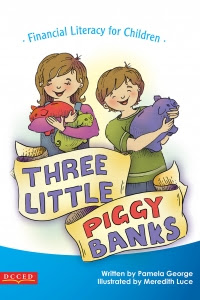| ________________
CM . . .
. Volume XXIV Number 28. . . .March 23, 2018

 |
Three Little Piggy Banks. (Financial Literacy for Children).
Pamela George. Illustrated by Meredith Luce.
Ottawa, ON: DC Canada Education Publishing, 2016.
37 pp., pbk., $12.95.
ISBN 978-1-77025-176-6.
Subject Headings:
Money-Juvenile fiction.
Thriftiness-Juvenile fiction.
Sharing-Juvenile fiction.
Preschool-grade 2 / Ages 4-7.
Review by Dave Jenkinson.
**½ /4
|
| |
|

Excerpt:
Note to Parents and Teachers
Every day, I see how financial literacy causes homelessness, addictions, broken dreams, sickness, broken marriages and broken children. I see firsthand how this epidemic is passed on from generation to generation perpetuating the cycle of excessive debt and living pay cheque to pay cheque. My objective for this book is to give children an opportunity to finally break that cycle and allow them to be free from the burden of financial worries and to enjoy the freedom of financial sustainability.
If you did not stop to read the “excerpt” above, please go back and do so as it’s a clear explanation of the purpose Pamela George had in writing Three Little Piggy Banks. And the book is not to be just a read-to experience between parent and child. George’s expectation is that adults using the book with [a] child[ren] will actually begin to implement the Saving, Sharing and Spending concepts she describes. In fact, on the opening Note to Parents and Teachers page, she lists the items that adults should have in hand before they begin to read the book to a child: an intended weekly amount of money (allowance) divisible by three; three piggy banks or jars with lids; stars or coloured pencils; and copies of the worksheet found at the end of the book.
Twins Ella and Andy are about to share a birthday, and Ella anticipates her parents giving her the camera she wants while Andy expects a two-wheel bike. However, when the special day arrives, there is no camera or bike. Instead, the parents give each of them three piggy banks. While George correctly reflects the children’s initial disappointment, her bridge to how the gifts will be utilized is a bit "clunky".
"Sweethearts," Mom says. "When I was young like you, I never got gifts for my birthday. Here you have beautiful gifts. You should say thank you."
"Your dad and I spent a lot of time trying to find the perfect gifts for both of you," says Mom.
[Here, I could imagine real children thinking, “Mom, just because your parents were Grinches is no reason for you to punish us. Besides, we told you what the perfect gifts were.” At the same time, they are saying in unison and in a monotone voice the expected, “Thank you for our gifts Mom and Dad.”]
However, once past this point, George explanations of how the three piggy banks are to be used is quite clear, with the first step being their respective labels: Saving, Sharing and Spending. In turn, George goes through the purpose of each bank and asks the children what they would save for, with whom would they share their money and what they would purchase with their weekly “Spending” portion. As parents share the book’s contents, they could ask their own children how they could see themselves using each bank’s contents. George also demonstrates how the stars [or the coloured pencils for drawing stars] and the worksheet can be used to track savings and expenditures in each of the three banks.
One small weakness in the book is that George identifies the birthday that the twins are about to share - their fifth. Given that Luce’s cartoon-like illustrations are open to interpretation regarding the children’s ages, there was no reason for George to be so specific, especially when older children might initially think the book’s contents could be too babyish for them.
While the contents of Three Little Piggy Banks do provide a fine template for introducing the concept of financial stewardship to young children, the book requires the mediation of an adult. Consequently, George may be preaching to the choir, and those adults who presently mismanage their own finances will see no reason to purchase/borrow the book.
Recommended.
Dave Jenkinson, CM's editor, lives in Winnipeg, MB.

To comment on this title or this review, send mail to cm@umanitoba.ca.
© CM Association
CC BY-NC-ND
Hosted by:
University of Manitoba
ISSN 1201-9364
|
This Creative Commons license allows you to download the review and share it with others as long as you credit the CM Association. You cannot change the review in any way or use it commercially.
Commercial use is available through a contract with the CM Association. This Creative Commons license allows publishers whose works are being reviewed to download and share said CM reviews provided you credit the CM Association. |
Next Review | Table of Contents for This Issue - March 23, 2018.
CM Home | Back Issues | Search | CM Archive | Profiles Archive
|
